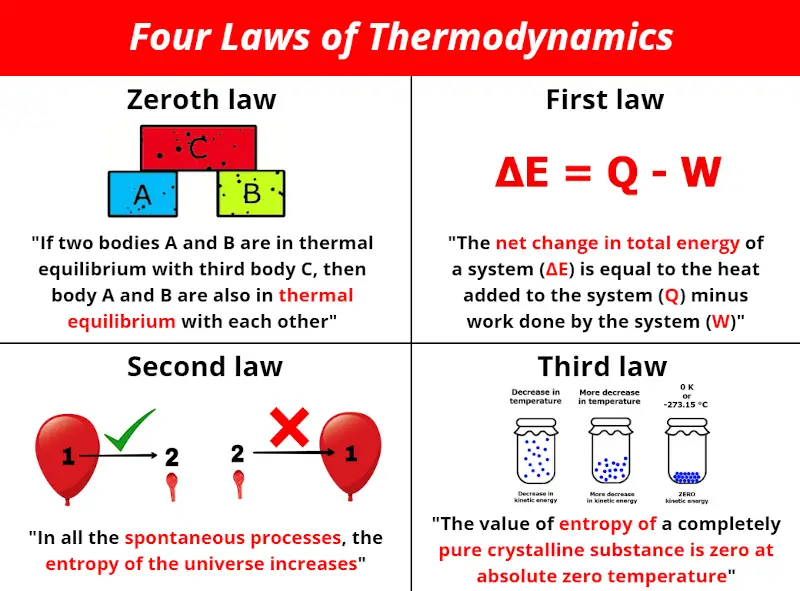
Even if you will not read this article, you will definitely understand all the laws of thermodynamics.
How?
Because I have explained all these laws of thermodynamics with amazing images. Just see the images and you are done with this topic.
A big question. How many laws of thermodynamics are there?

Well, there are total 4 laws of thermodynamics.
- Zeroth law of thermodynamics
- First law of thermodynamics
- Second law of thermodynamics and
- Third law of thermodynamics
I will give you a clear explanation of all these thermodynamics laws along with wonderful examples. And you will love to read this article.
I have also discussed some tricks to remember the difficult statements of all these four laws.
Infact, this is the exact trick which makes me remember all the four laws of thermodynamics very easily.
So let’s get started.
Contents
Zeroth law of thermodynamics
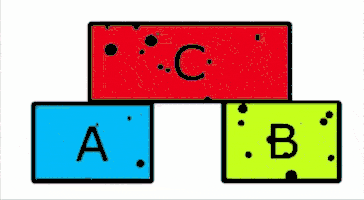
This is very easy, trust me.
I’ll explain to you the zeroth law of thermodynamics with this simple animation.
As a student, you should have one question in your mind.
Why is this law named zeroth? It should start from one.
It should be like first, second, third, etc. But why is it named “zeroth”?
Why is there a zeroth law of thermodynamics?

It was 1935, when Ralph Fowler was reading a book and he came upon one text – “Every physical quantity must be measurable in some numeric terms”
No one was knowing about the term “temperature” before 1935.
And main thing, all the three laws of thermodynamics (first, second and third law) were already discovered before 1935.
In 1935, Fowler discovered the title “Zeroth law of thermodynamics” and thermal equilibrium.
Fowler realized that this phenomenon of thermal equilibrium is very important and it should be discussed before the first law of thermodynamics as this law shows the presence of one important property “Temperature“.
But already so many books were published with the first law, second law and third law. Now changing the number of these three laws can create a lot of confusion.
Thus he was forced to adopt the number “zero” for his law.
This is the reason why this law is called the zeroth law of thermodynamics.
What is the zeroth law of thermodynamics?
Consider three bodies. Body A, body B, and body C.

Zeroth law of thermodynamics states that
“If two bodies A and B are in thermal equilibrium with third body C, then body A and B are also in thermal equilibrium with each other.”
This may be difficult for you to understand. Let me explain to you in a simple way.
Just see the above animation. Consider 3 bodies A,B and C. All these three bodies are initially at different temperatures.
Body A and body B are separated from each other (see animation). And both these bodies are in contact with the third body C.
After few minutes, body A will be in thermal equilibrium with body C and same way body B will also be in thermal equilibrium with body C.
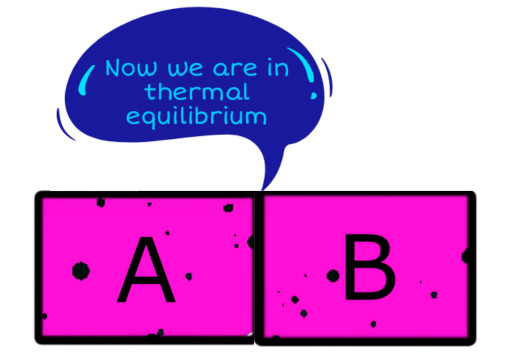
After this condition, if body A and body B are kept in contact with each other, then there will be no heat transfer between them. This means that both these bodies (A & B) are now in thermal equilibrium with each other. (Just see the color change in the animation as well as above image. You will get the exact idea)
Thus if body A is in thermal equilibrium with body C and body B is also in thermal equilibrium with body C, then body A and B are also in thermal equilibrium with each other.
Thus can be written mathematical as;
If Ta = Tc and Tb = Tc, then according to zeroth law of thermodynamics Ta = Tb. Where Ta, Tb and Tc are the temperatures of body A, B and C respectively.
Now something amazing is coming.
Keep reading!!!
What did you find from the zeroth law of thermodynamics?
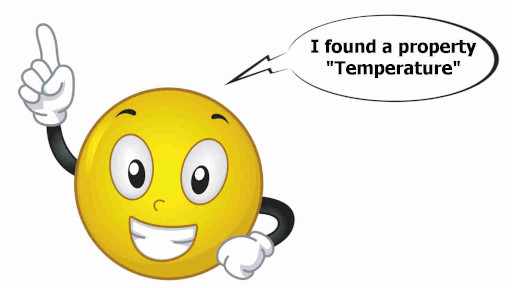
Yes, it’s a fundamental property “Temperature”.
This physical property tells us whether two bodies are in thermal equilibrium or not.
If the temperature of bodies are same, then the bodies are in thermal equilibrium with each other.
Simply I just want to say that the 0th law of thermodynamics helps us in finding the temperature of the object or body.
Application of zeroth law of thermodynamics
1). Measuring human body temperature
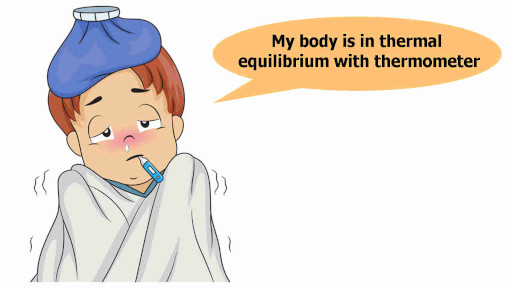
2. Measuring atmospheric temperature
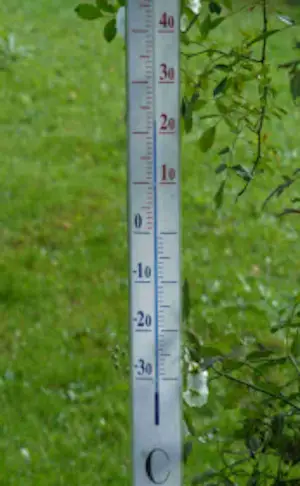
3. Temperature measurement for industrial applications
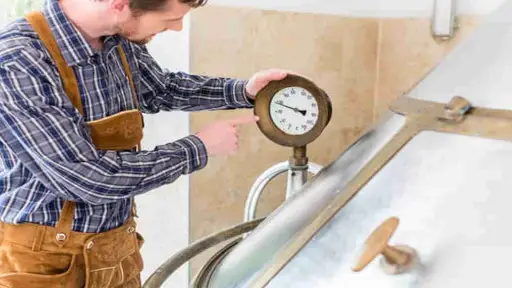
4. Temperature measurement in air conditioner
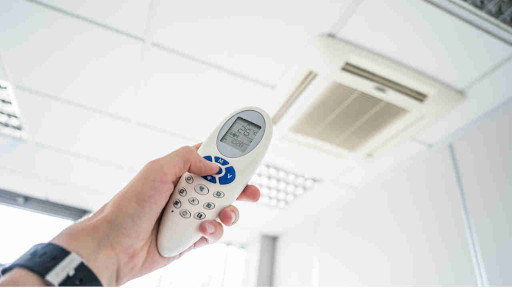
5. Temperature measurement in refrigerator

6. Application in food processing industries

More detailed information about temperature, temperature measuring instruments and how temperature is related to the zeroth law of thermodynamics, what is thermal equilibrium and how it is related to zeroth law and many more things are discussed in the separate article of “Zeroth law of thermodynamics“.
Do check out this article too.
Now let us discuss remaining three laws of thermodynamics in a simple way.
First law of thermodynamics

After watching this animation, you may think that it’s a Diwali or a Christmas celebration. Isn’t it?
Yes, but what happens when the crackers burst?
The chemical energy of the crackers are converted into heat and sound energy.
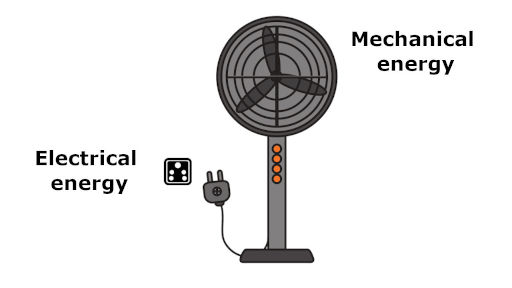
Guess what happens here?
The electrical energy is converted into mechanical energy of fan.

You can see here, the conversion of electrical energy into heat energy. The coil becomes hot because of electric current.

I guess you are more familiar with this example. The heat energy of fuel is converted into a mechanical energy.
Now let me give you the exact idea about the first law of thermodynamics.
First law of thermodynamics:
“Energy can neither be created nor can be destroyed but transformation of one form into another form can be possible.”
This means that the total amount of energy in the universe remains constant.
Don’t worry, I will explain to you all the concepts of the first law of thermodynamics along with the practical examples occurring in daily life.
I’ll also explain to you why this law is also known as law of conservation of energy.
Keep reading…
There are many types of energies like;
1). Heat energy

2). Mechanical energy
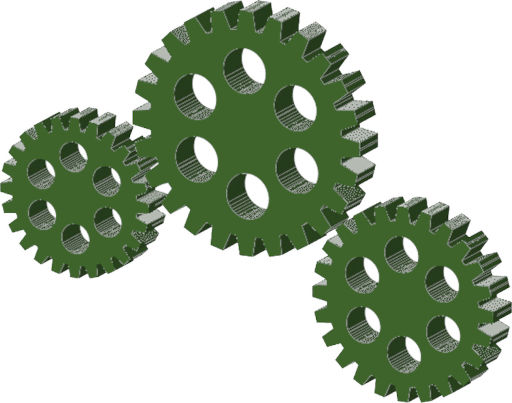
3). Chemical energy
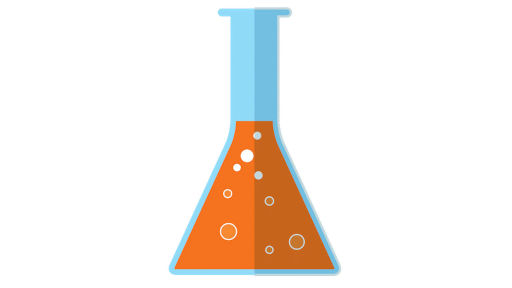
4). Electrical energy

All these energies mentioned above can be converted from one form to another.
But do you know how this will occur?
Let’s take an example which you already know.
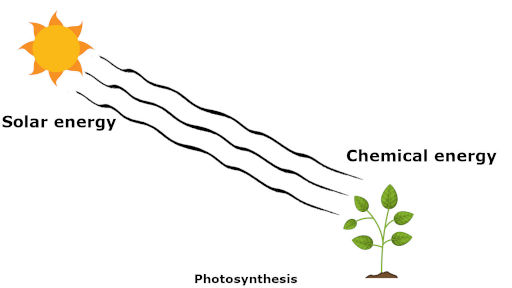
The heat energy of the sun is absorbed by the plants and it is stored in plants in the form of chemical energy. So it’s a conversion of heat energy into chemical energy.

You have already seen the fans, grinder, mixer machine, etc in which the rotor or motor rotates with the help of electric power.
Thus the electrical energy is converted into a mechanical energy.

Now what type of energy conversion is taking place here?
We have already seen this example in the previous section of this article. It’s a conversion of electrical energy into heat energy.
This is how the 1st law of thermodynamics or law of conservation of energy appears here.
Now see, there are two more important classification of energies.
- Kinetic energy
- Potential energy
Kinetic energy: Kinetic energy is the energy which an object possess due to its motion.

If any object moves with some velocity, then it possess kinetic energy in it.

If any object is at some height from the ground level, then it possess potential energy in it.
Now let us see how these two energies are converted from one form to another.

This boy is holding a stone which is at some height. That means it has some potential energy right now.
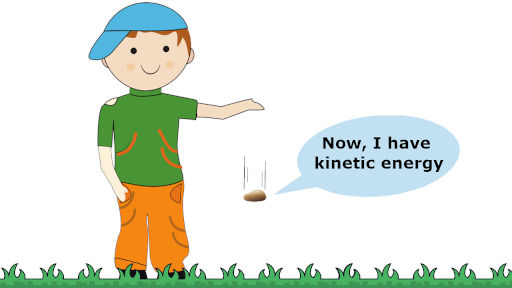
Now the boy has released the stone. So the stone starts to move downward.
Now the stone is in motion. So which energy it possess?
It’s a kinetic energy right?
Thus the potential energy of stone is converted into a kinetic energy. Here also the energy is conserved. The energy is just converted from one form to another (potential energy into kinetic energy).
Thus according to the first law of thermodynamics or law of conservation of energy, the energy remains conserved.
So many energies in a single picture (short and sweet)
Well, I’ll show you so many energies converting from one form to another in a single picture.
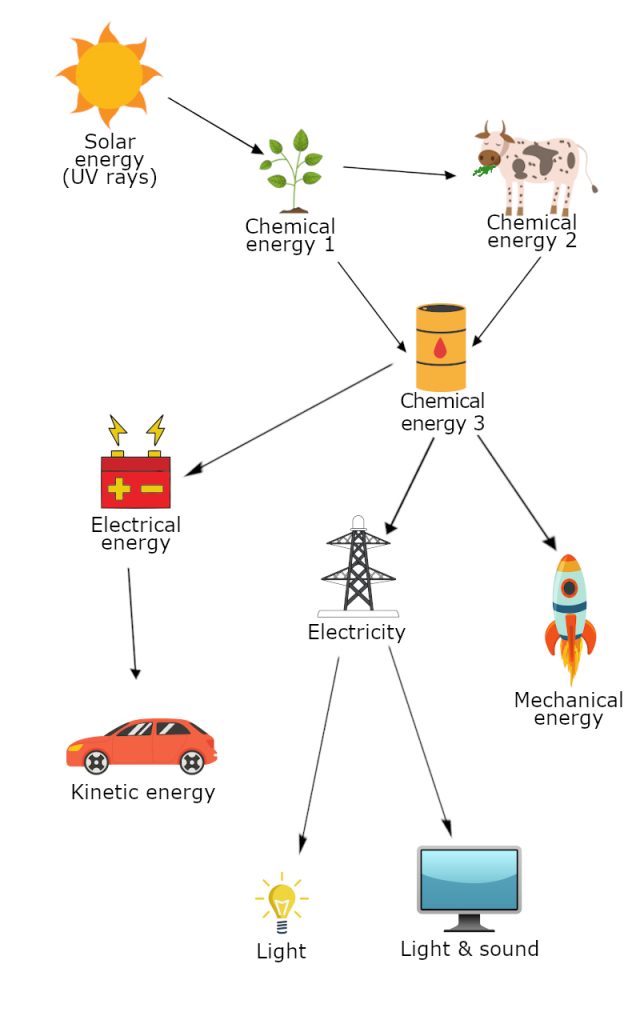
I hope you have understood every single conservation of energy from the image itself.
Now let’s see the equation of first law of thermodynamics.
Equation for first law of thermodynamics

Let me tell you my personal story.
When I was a student, I faced many problems in understanding the mathematical form of first law of thermodynamics.
But then I read from books, internet and I also learned from my teacher.
Now I have found the best way to remember this equation of first law of thermodynamics.
Infact the example which I have mentioned in this explanation makes me remember the first law very easily. And this will work for you too.
Here I will explain you the entire concept hidden in the equation of 1st law of thermodynamics. (Trust me, you will love to read this)
In previous section, we saw that 1st law of thermodynamics is nothing but a law of conservation of energy.
We learned that;
“Energy can neither be created nor can be destroyed but transformation of one form into another form can be possible.”
Now for the mathematical form, the equation of first law of thermodynamics includes heat (Q), work (W), and internal energy (U).
In terms of heat, work and internal energy, the statement/definition of first law of thermodynamics can be stated as;
“First law of thermodynamics: The net change in total energy of a system (∆E) is equal to the heat added to the system (Q) minus work done by the system (W).”
I know, it’s difficult to understand this statement.
So I have prepared a simple example for you. Let’s proceed further.
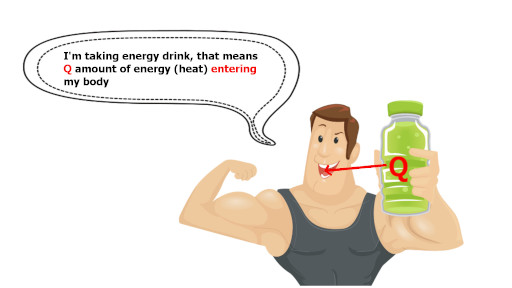
You can see here, that the boy is taking the energy drink which is having Q amount of energy. That means Q amount of energy is entering his body.
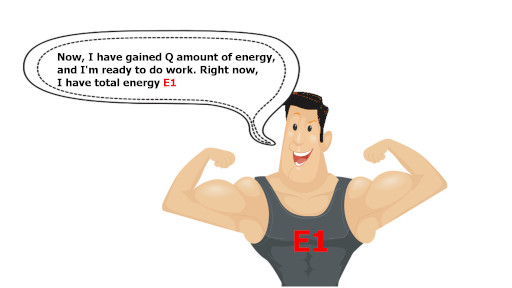
Now this muscular boy has gained Q amount of energy and now he is ready to do work. And right now he is having total energy E1.
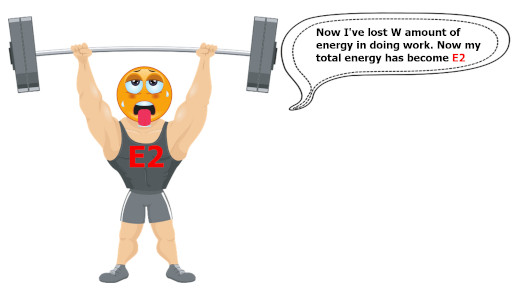
Now this boy spends W amount of energy in doing some work. He loses some energy and now finally his total energy reduces to E2.
Let’s see this situation in some mathematical form.
Now here,
Q = Inlet energy to the body
W = Outlet energy in the form of work
E1 = Total energy that boy is having during initial state
E2 = Total energy that boy is having during the final state
Here, this muscular boy gains Q amount of energy and she spends W amount of energy.
So we can say that the change in total energy of the body is Q – W.
This change in total energy is nothing but E2 – E1.
So this situation can be mathematically represented as;
E2 – E1 = Q – W
Therefore, ∆E = Q – W
This equation is known as first law of thermodynamics.
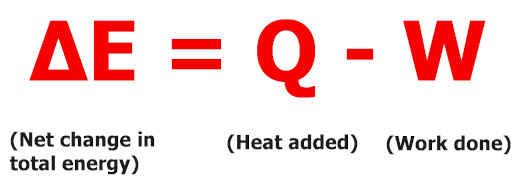
Now, it is easy for you to understand this statement/definition of 1st law.
First law of thermodynamics: The net change in total energy of a system (∆E) is equal to the heat added to the system (Q) minus work done by the system (W).
Now let us discuss the effect of heat (Q) and work (W) on the total energy change of the system (∆E)
When the system gains some heat (Q), then the value of net change in total energy (∆E) increases.
And if some work (W) is done by the system increases, then value of W will increase, which results in decrease in the value of change in total energy (∆E)
(It’s simple, just refer the equation ∆E = Q – W)
More detailed information about heat (Q), work (W), internal energy change (∆U), sign conversion for heat and work, perpetual motion machine, limitations of first law of thermodynamics, and many more things are discussed in the separate article of “first law of thermodynamics“.
Do check out this article too.
Second law of thermodynamics
I’ll explain this law with an example.

The air leaks from the balloon on it’s own.
You might have seen this on your birthday or your friend’s birthday.
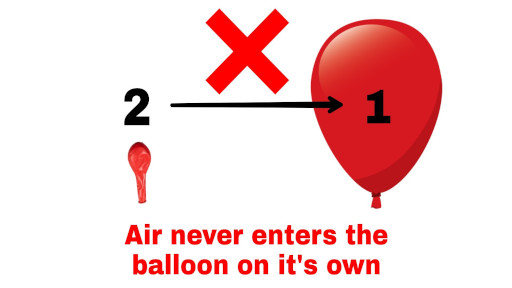
But have you seen the balloon getting automatically filled up with air without doing anything?
Obviously No.
Well, I know that the second law of thermodynamics seems very confusing as it has more complex terms in it.
Also this law comes in physics subject as well as chemistry subject.
But do not worry at all, I will explain to you the second law of thermodynamics with amazing examples and tricks to remember.
Let’s move to another example.
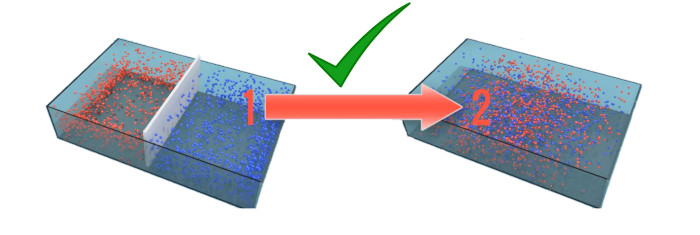
What will happen if you will remove the white separator as shown in the above image?
Obviously both the gases will get mixed up with each other on it’s own.
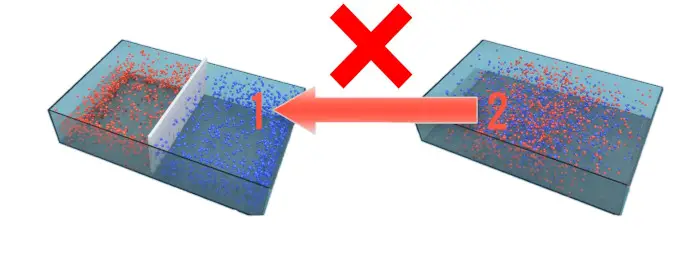
Now what about the reverse process? Is it possible to have the separate gases from the mixture by placing the separator again?
No, it is not possible.
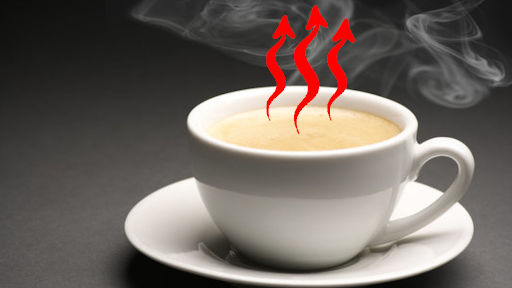
If you keep the hot coffee in the room, then it will lose its heat and it will cool down on it’s own without any external help.
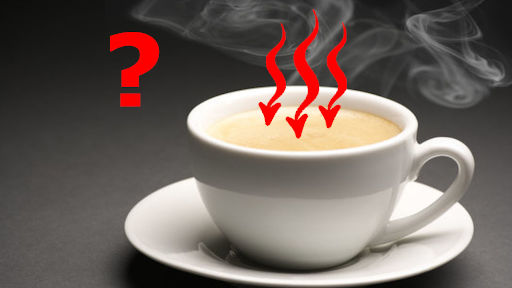
What about the reverse process?
Will this coffee absorb the heat on it’s own?
No, it won’t.
Well, the 2nd law of thermodynamics is all about this only. By using the second law of thermodynamics, we can come to know whether the process occurs on it’s own or not?
You might think that it’s very easy to know whether the process occurs on it’s own or not.
You can predict it very easily. Yes I completely agree with you. You can predict it easily.
But in some cases it becomes very difficult to predict whether the process will occur on it’s own or not? (For example chemical reactions)
In such cases, the second law of thermodynamics comes into play.
There are various statements/definition for the 2nd law of thermodynamics based on heat engine, heat pump and entropy.
I’ll discuss all three statements along with examples so that you can get the clear idea about the same.
Most important question. Why do we use the second law of thermodynamics?

In previous examples you noticed that;
- Air leaks from the balloon
- Hot coffee becomes cold on it’s own
- Two gases gets mixed up on it’s own if they are allowed to mix in a container
- Heat flows from higher temperature body to the lower temperature body
You have noticed that all these process occur on it’s own and also they occur in a particular direction only.
Now statement/definition of 2nd law of thermodynamics tells us the direction in which these process will occur.
Let’s take an example for more clarification.

In the left image you can see that the heat is released from the hot coffee cup and that is absolutely true. This process occurs on it’s own.
But what about the second image?
Is the reverse process possible? And will it occur on it’s own?
Well, according to the first law of thermodynamics, this is possible. First law of thermodynamics says that energy can be transferred from one form to another. So this heat energy of the room can be transferred back to the coffee and coffee will become hot.
But in actual practice, we know that it is not possible and this heat will not enter the cup of coffee on it’s own. Right?
This is only the limitation of first law of thermodynamics that it does not tell us the direction of the process to occurs. In this example of coffee cup, first law of thermodynamics fails to determine the direction of spontaneous heat transfer (it does not say whether spontaneous heat transfer takes place from coffee to room or from room to coffee)
In order to solve this limitation of first law of thermodynamics, the second law of thermodynamics was discovered.
Thus,
- Second law of thermodynamics is used to check whether the process is spontaneous or not. (Whether the process occurs on its own or not?)
- It also tells us the direction in which the process will proceed.
What is Second law of thermodynamics?
It’s very simple, trust me.
The second law of thermodynamics can be stated in three ways.
- Second law of thermodynamics for heat engine (Kelvin Planck’s statement)
- Second law of thermodynamics for heat pump/refrigerator (Clausius’s statement)
- Second law of thermodynamics based on entropy
Let us discuss all these three statements one by one.
Second law of thermodynamics for heat engine (Kelvin Planck’s statement)

This single picture is enough to understand the Kelvin Planck’s statement of second law.
Kelvin Planck’s statement:
“It is impossible to construct a device (operating in a cycle) which works on a single heat source and converts all of its heat completely in to work”
Don’t work, I’ll simplify this in my own words for your better understanding.
This Kelvin Planck’s statement simply wants to say that – “A heat engine must exchange the heat with at least two thermal reservoirs, one at higher temperature and other at lower temperature, then only the engine will operate.”
Or
“Perfect engine with 100% efficiency is impossible”
Let me clarify this with an example.

What did you notice from the above picture. You can see that the heat engine is absorbing all the heat and producing the equal amount of work from it.
This phenomenon is valid according to the 1st law of thermodynamics. (Law of conservation if energy, heat energy is complete converted into mechanical energy)
Yes and the exact process occurs over here.
So according to the first law of thermodynamics, this above mentioned process is possible.
But this heat engine is not having any lower temperature reservoir to absorb the heat. So according to the second law of thermodynamics, this type of heat engine is not possible, which works on a single heat source.
Kelvin Planck’s statement says that there must be at least two temperature reservoirs, one at higher temperature and other at lower temperature to operate the heat engine.
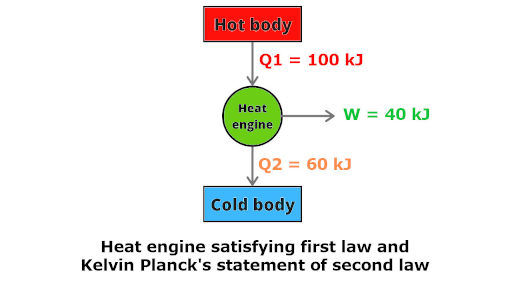
Now see this picture, this type of heat engine is possible according to Kelvin Planck’s statement of second law, because it is operating between two temperature reservoirs, one at higher temperature and other at lower temperature.
This type of engine will have efficiency less than 100%.
Thus this engine working between the two temperature reservoirs obeys the first law as well as second law of thermodynamics.
Still not getting the exact idea?
Look, we all know that heat transfer always takes place from higher temperature body to the lower temperature body.
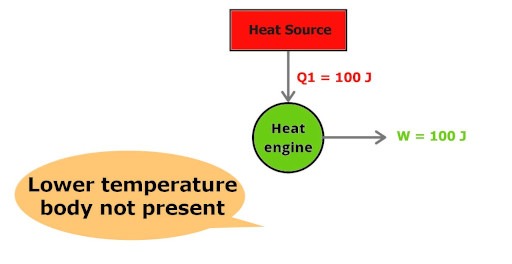
But here we do not have any lower temperature body so heat transfer can not takes place over here in this case. And thus, this heat cannot be converted into useful work without any heat transfer.
This is what Kelvin Planck’s statement wants to say. (Let me know in comments if you have any queries)
How to remember Kelvin Planck’s statement?
Remember these two sentence:
“A heat engine must exchange the heat with at least two thermal reservoirs, one at higher temperature and other at lower temperature, then only the engine will operate.”
And
“Perfect engine with 100% efficiency is impossible”
Let’s move further, now let me explain you Clausius’s statement.
Second law of thermodynamics for heat pump/refrigerator (Clausius’s statement)
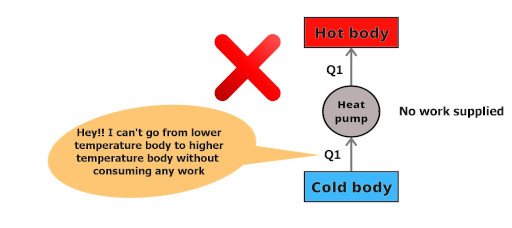
This single image will make you understand Clausius’s statement very easily.
Clausius’s statement:
“It is impossible to construct a device (operating in a cycle) that can transfer heat from cold body to the hot body without absorbing any work.”
Or
“Heat can not itself flow from colder body to a hotter body.”
Don’t worry, just see the above image. Heat Q1 is at lower temperature body and it is saying that it will not travel to higher temperature body without absorbing any work.
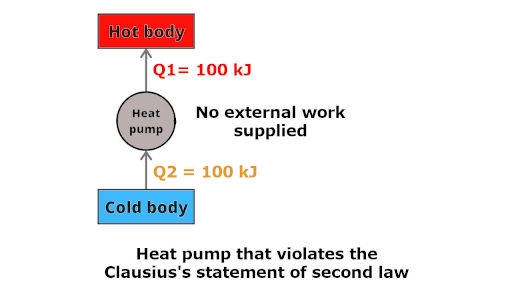
In this heat picture, you can see that heat pump is absorbing heat from the lower temperature body and rejecting it to the higher temperature body without supply of any work.
If we talk about the first law of thermodynamics, then this phenomenon is possible. But it does not obey the Clausius’s statement of the second law of thermodynamics. Thus, such type of device is not possible which transfers heat from lower temperature body to the higher temperature body without supply of any work to it.
So according to the Clausius’s statement of second law of thermodynamics, such type of heat engine is not possible.

Now see this picture, this heat pump is consuming some work, and because of this, heat is transferred from lower temperature body to higher temperature body. The heat pump shown in above line diagram satisfies first law of thermodynamics as well as Clausius’s statement of the second law of thermodynamics.
How to remember Clausius’s statement?
Just remember this simple sentence;
“Heat always flows from higher temperature body to lower temperature body. It’s reverse flow does not take place on its own.”
Hope you have understood this!
If not, then kindly read it again (hahaha….)
Second law of thermodynamics based on entropy
Before starting this, you should know the meaning of one term i.e “Entropy“.
Let me explain this to you with a short and sweet example.
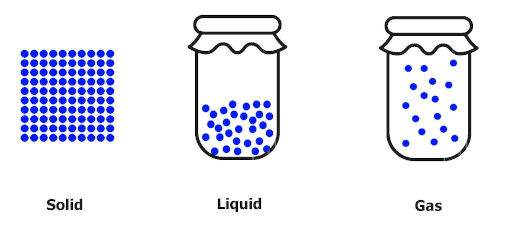
What type of arrangements of molecules can you see in solids, liquids and gases?
Well, the molecules in solids are arranged in a proper manner.
In liquids, the molecules are little bit disordered as you can see in the above container.
While in gases, the gas molecules are showing maximum disorder and it occupies the entire volume of the container.
This disorder or movement of molecules is known as randomness
Now, the main question is “What is entropy?”
Entropy is nothing but the measurement of this randomness.
So entropy can be defined as;
The measurement of randomness of the system is known as Entropy.
Or
Entropy is the measurement of disorder of the system.
It’s simple, it is just a measurement of how much randomly the molecules are moving in a system.
- In solids, the molecules are properly arranged, that means it has less randomness, so entropy of solids is least.
- In gases, the molecules move very fast throughout the container. It has more randomness which means it has more entropy.
- The entropy of liquids lies in between the solids and liquids
The formula for a change in entropy is given by;
∆S = ∆Q/T
Now, you will completely understand the second law of thermodynamics based on entropy.
Keep reading…
Entropy statement of Second law of thermodynamics
“In all the spontaneous processes, the entropy of the universe increases.”
Second law of thermodynamics equation (formula) can be stated as below;


Second law of thermodynamics equation is very important as it gives information about entropy. By knowing the entropy change, we can come to know whether the process will occur on it’s own or not.
One thing I want to tell you that whatever process occurs around us are based on this entropy principle of second law of thermodynamics.
Let’s see few examples of second law of thermodynamics (based on entropy statement) in our daily life.

When this hot cup of coffee is placed on a table, it will cool down automatically (on its own).
In thermodynamic terms, we can say that hot coffee loses heat to the surrounding.
Now, you might be thinking that, what’s the role of entropy in this phenomenon?
Well, in this cooling of coffee, the entropy plays a very important role.
Let me show you this with a mathematical proof.
Assume that;
-The temperature of coffee is 50 °C. (i.e 323 K)
-The temperature of surrounding is 20 °C. (i.e 293 K)
Now, there are two possible case
- The coffee may absorb heat from the surrounding, or
- The coffee may release heat to the surrounding.
But, what will happen from these two cases? Let’s find it out through some calculations.
Case 1: Coffee is absorbing heat from the surrounding
Let say coffee (system) absorbs 10 joules of heat from the surrounding.
That means, the surrounding will lose 10 joules of heat.
So we can write,
Qsystem = +10 J
Qsurrounding = -10 J
Now, change in entropy of universe is given by equation;
∆Suniverse = ∆Ssystem + ∆Ssurrounding
= ∆Qsystem/Tsystem + ∆Qsurrounding/Tsurrounding
= (+10/ 323) + (-10/293)
= -0.00316 J/K
This is a negative value,
The entropy of the universe is decreasing here. Thus it violates the second law of thermodynamics (∆Suniverse should be greater than 0, but here our answer is negative).
So, we can say that this process is non spontaneous. This process of absorbing heat from the surrounding will not occur on its own.
Now, let’s take another case.
Case 2: Coffee is releasing heat to the surrounding
Let say coffee (system) releases 10 joules of heat to the surrounding.
That means, the surroundings will absorb 10 joules of heat.
So we can write,
Qsystem = -10 J
Qsurrounding = +10 J
Now, change in entropy of universe is given by equation;
∆Suniverse = ∆Ssystem + ∆Ssurrounding
= ∆Qsystem/Tsystem + ∆Qsurrounding/Tsurrounding
= (-10/ 323) + (+10/293)
= +0.00316 J/K
This is a positive value,
Kudos!! The entropy of the universe is increasing here. Thus it satisfies the entropy statement of second law of thermodynamics (∆Suniverse should be greater than 0).
So, we can say that this process is spontaneous. This process of releasing heat to the surrounding will occur on its own.
Well, in the above example you were already knowing that coffee is going to lose heat to the surrounding.
But in some other examples of chemical reactions, you may not be able to predict whether the chemical reaction will occur on its own or not.
So, calculating the entropy change for that particular reaction becomes important.
I hope you have clearly understood the Second law of thermodynamics in terms of entropy. Now let’s move further. Keep reading… The practical applications of this 2nd law of thermodynamics are on the way.
I want to keep this article short. So if you want want to read the practical daily life examples of second of thermodynamics, kindly check this article in which I have explained amazing daily life examples and practice problems on second law:
Check out: Second law of thermodynamics with amazing examples
Well l, I hope you have got the clear idea of the 1st and 2nd laws of thermodynamics. Now let us move to the last law i.e third law of thermodynamics.
Third law of thermodynamics

Let me tell you a real story before starting the third law of thermodynamics.

When German chemist Walter Herman Nernst studied about the 2nd law of thermodynamics, his mind was completely disturbed.
In the second law of thermodynamics, he studied that the entropy of the universe always keeps on increasing for all the process which occur on their own.
His mind blinked with a question
“What should be done so that the entropy of the universe will not increase and remains constant?”
He studied everything about entropy. After a lot of study and research work, he discovered the Third law of thermodynamics.
He stated Third law of thermodynamics as;
“The value of entropy of a completely pure crystalline substance is zero at absolute zero temperature”
I know it seems little bit difficult for you to understand what this Third law wants to say?
Don’t worry, I will explain to you the entire concept of Third law of thermodynamics with amazing examples. (You will definitely love this)
Before this, let us recall the concept of Entropy.
We have seen in the previous section of this article, that entropy is the measurement of disorder or randomness of the system.
Having recalled this, let’s move further.
Just think what happens when we heat any substance?
If we heat any substance, then it’s temperature will increase. Now, due to increase in temperature, the atoms and molecules inside that substance will start vibrating with a greater speed. The oscillations, linear motion as well as rotational motion of the molecules will increase. Thus the randomness or disorder of the molecules will increase and we can say that the Entropy of the substance has increased.
Now, what happens when we cool down any substance?
The answer is simple. The oscillations, vibrational, linear motion as well as rotational motion of the molecules will decrease. This results in decrease of disorder and the Entropy of the substance also decreases.
The third law of thermodynamics states that the entropy of a pure crystalline substance is zero at absolute zero temperature.
Means if we have a pure crystalline substance and if we keep on cooling that substance up to absolute zero temperature (0 K or -273.15 °C or -459.67 °F), then it’s atoms will stop moving.
That’s it !!
Did you enjoy this? Keep reading…
What is absolute zero temperature? Is it possible to achieve?
Absolute zero temperature is:
- 0 Kelvin or
- -273.15 °C or
- -459.67 °F
Absolute zero temperature is the coldest possible temperature in the universe (and it is 0 K).
(It is “Zero Kelvin”. Don’t read it like “okay”). Hahahah
Absolute zero is so so sooooooooooo…… much colder than whatever you might have experienced in your life.
It is that much cold temperature at which all the atoms and molecules of the substance will get freezed up.
Even a gas like oxygen, carbon dioxide, nitrogen and all other gases get freezed up at this absolute zero temperature (0 K or -273.15 °C or -459.67 °F)
Let me explain to you this concept with a simple picture.
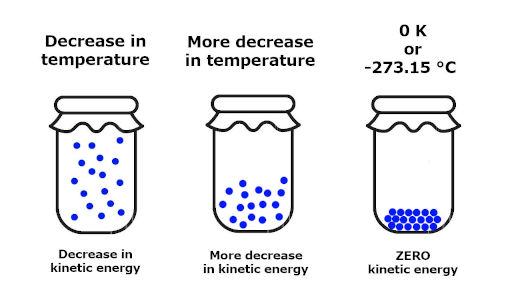
We see that if the temperature of substance decreases, then it’s molecular motion also decreases. That means it’s Kinetic energy decreases.
Now as shown in the above picture, if we keep of reducing the temperature of the substance, then it’s kinetic energy also decreases.
As shown in above picture, if the absolute zero temperature is reached, then all the molecular motion stops and it’s kinetic energy becomes zero.
Thus, there will be no disorder in the system, and thus we can say that the it’s entropy is zero.
Is absolute zero temperature possible?
The answer is “No”
Scientists know that such temperature exist. But they have never been able to achieve this lowest temperature even by using many scientific techniques and freezers. Scientists have achieved temperature somewhat close to absolute zero in a laboratory, but not exactly 0 K.
Why is absolute zero not possible? (simple)

You know why this temperature is not reachable?
I’ll explain to you in a short and simple way.
According to the second law of thermodynamics, heat will move from the warmer body to a colder body. So if we try to cool down the object to absolute zero, then that object will keep on receiving heat from the surrounding and so it’s just a theoretical concept.
Thus absolute zero temperature is practically not possible.
There are lot more things about the third law of thermodynamics like;
- What is a pure crystalline substance in third law of thermodynamics?
- Application of third law of thermodynamics
- Which substances do not follow third law of thermodynamics?
- Mathematical form of third law of thermodynamics
All these valuable knowledge regarding the third law is mentioned in this detailed guide on third law of thermodynamics
Hope you enjoyed all these 4 laws of thermodynamics and their applications.
Now let me summarize everything in a simple summary (for your revision)
Summary (Read this if you are in hurry)
A big question. How many laws of thermodynamics are there?
There are total four laws of thermodynamics.
- Zeroth law of thermodynamics
- First law of thermodynamics
- Second law of thermodynamics and
- Third law of thermodynamics
Summary of these four laws of thermodynamics is given below.
Zeroth law of thermodynamics
“If two bodies A and B are in thermal equilibrium with third body C, then body A and B are also in thermal equilibrium with each other.”
What did you find from the zeroth law of thermodynamics?
From the zeroth law of thermodynamics we found that there is one physical property which indicates whether the bodies are in thermal equilibrium or not. And that property is Temperature.
Application of zeroth law of thermodynamics
1). To measure human body temperature.
2). To measure atmospheric temperature.
3). Temperature measurement for industrial applications.
4). Temperature measurement in air conditioners.
5). Temperature measurement in refrigerator.
6). In food processing industries.
First law of thermodynamics:
“Energy can neither be created nor can be destroyed but transformation of one form into another form can be possible.”
Equation that expresses first law of thermodynamics
“The net change in total energy of a system (∆E) is equal to the heat added to the system (Q) minus work done by the system (W).”
∆E = Q – W
Second law of thermodynamics
Most important question. Why do we use the 2nd law of thermodynamics?
- Second law of thermodynamics is used to check whether the process is spontaneous or not. (Whether the process occurs on its own or not?)
- It also tells us the direction in which the process will proceed.
What is Second law of thermodynamics definition/statement?
The statements/definition of second law of thermodynamics are discussed below;
Kelvin Planck’s statement:
“It is impossible to construct a device (operating in a cycle) which works on a single heat source and converts all of its heat completely in to work”
Clausius’s statement:
“It is impossible to construct a device (operating in a cycle) that can transfer heat from cold body to the hot body without absorbing any work.”
Or
“Heat can not itself flow from colder body to a hotter body.”
Entropy statement of Second law of thermodynamics:
“In all the spontaneous processes, the entropy of the universe increases.”
Third law of thermodynamics:
“The value of entropy of a completely pure crystalline substance is zero at absolute zero temperature”
What is absolute zero temperature? Is it possible to achieve?
Absolute zero temperature is the coldest possible temperature in the universe (and it is 0 K).
Is absolute zero temperature possible?
The answer is “No”
Why is absolute zero not possible?
According to the second law of thermodynamics, heat will move from the warmer body to a colder body. So if we try to cool down the object to absolute zero, then that object will keep on receiving heat from the surrounding and so it’s just a theoretical concept.
Thus absolute zero temperature is practically not possible.
Also read:
- What is thermodynamics? (35+ topics with definitions and examples)
- Zeroth law of thermodynamics
- What is First law of thermodynamics?
- First law of thermodynamics definition/statement (In simple way)
- Examples of First Law of Thermodynamics / Law of conservation of Energy
- First law of thermodynamics equation (A practical explanation)
- Limitations of First Law of Thermodynamics
- What is second law of thermodynamics? [8+ Best examples to remember the law]
- Examples of Second Law of Thermodynamics (8+ best examples)
- Second Law of Thermodynamics Definition/Statement (Next level explanation)
- Second Law of Thermodynamics Equation [Practical explanation]
- What is third law of thermodynamics? (in simple terms)
- What is Carnot Cycle in Thermodynamics?
- What is the definition of entropy in thermodynamics?
- Heat capacity vs specific heat in thermodynamics
- What is Thermodynamic Equilibrium? (With Best Example)
- Thermodynamic Process (With Examples)
- What is Thermodynamic System? – Open, Closed & Isolated system (With Examples)
